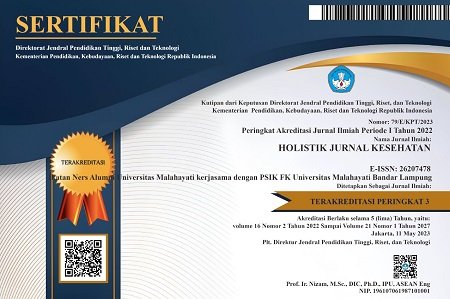Gender dan resiko kecenderungan body dysmorphic disorder pada remaja akhir
Abstract
Background: Adolescence is a period of rapid development in the physical and psychological aspects. Negative judgments from other people on the physical aspect and appearance are one of the things that can cause distress for adolescents. Distress that may occur is that adolescents feel dissatisfied with their physical condition or appearance and compare their physical condition with the physical condition of other people to affect functional ability, which is called body dysmorphic disorder.
Purpose: To determine the correlation between gender and the risk of body dysmorphic disorder in late adolescents.
Method: This research is a correlational analytic study with a cross sectional approach. Respondents in this study were 191 adolescents who were selected using the cluster sampling technique. Data collection used a body dysmorphic disorder tendency questionnaire with a validity and reliability test value of Cronbach's Alpha α = 0.722. The research data were analyzed using the Chi-Square Test.
Results: Most of the respondents were women as many as 134 respondents or 70.2% and as many as 63 respondents or 33.0% had a moderate risk of body dysmorphic disorder, and as many as 62 respondents or 32.5% had a high risk of body dysmorphic disorder. The results of the analysis using the Chi-Square Test obtained a value of 0.000 <0.05 so that it can be concluded that H0 is rejected and H1 is accepted.
Conclusion: There is a significant correlation between gender and the risk of developing body dysmorphic disorder in late adolescence.
Keywords: Body Dysmorphic Disorder; Gender; Late Adolescents
Pendahuluan: Masa remaja merupakan masa dimana perkembangan pada aspek fisik dan psikologis berkembang dengan pesat. Penilaian negatif dari orang lain terhadap aspek fisik dan penampilan merupakan salah satu hal yang dapat menimbulkan distress bagi remaja. Salah satu bentuk distress yang mungkin terjadi yaitu remaja merasa tidak puas dengan kondisi fisik ataupun penampilannya dan membandingkan keadaan fisiknya dengan keadaan fisik orang lain hingga mempengaruhi kemampuan fungsional atau yang disebut dengan body dysmorphic disorder.
Tujuan: Untuk mengetahui hubungan jenis kelamin dengan resiko kecenderungan body dysmorphic disorder pada remaja akhir.
Metode: Penelitian ini adalah penelitian analitik korelasional dengan pendekatan cross sectional. Jumlah sampel dalam penelitian ini adalah sebanyak 191 responden yang dipilih menggunakan teknik cluster sampling. Pengumpulan data menggunakan kuesioner kecenderungan body dysmorphic disorder yang telah dilakukan uji validitas dan reliabilitas dengan nilai Alpha Cronbach’s α = 0.722. Data hasil penelitian dianalisis menggunakan Uji Chi-Square.
Hasil: Sebagian besar responden adalah perempuan sebanyak 134 responden atau 70.2% dan sebanyak 63 responden atau 33.0% memiliki resiko kecenderungan body dysmorphic disorder kategori sedang, dan sebanyak 62 responden atau 32.5% memiliki resiko kecenderungan body dysmorphic disorder kategori tinggi. Hasil analisis dengan Uji Chi-Square didapatkan nilai 0,000<0,05 sehingga dapat disimpulkan H0 ditolak dan H1 diterima.
Simpulan: Ada hubungan yang signifikan antara jenis kelamin dengan resiko kecenderungan body dysmorphic disorder pada remaja akhir.
Keywords
References
Adlya, S. I., & Zola, N. (2019). Kecenderungan Body Dysmorphic Disorder pada Remaja. JRTI (JURNAL Riset Tindakan Indonesia), 4(2), 59–62. Diakses dari: https://jurnal.iicet.org/index.php/jrti/article/view/269.
Bjornsson, A. S., Didie, E. R., & Phillips, K. A. (2022). Body dysmorphic disorder. Dialogues in clinical neuroscience.
Brohede, S., Wingren, G., Wijma, B., & Wijma, K. (2013). Validation of the Body Dysmorphic Disorder Questionnaire in a community sample of Swedish women. Psychiatry research, 210(2), 647-652.
Gracia, F., & Akbar, Z. (2019). Pengaruh harga diri terhadap kecenderungan body dysmorphic disorder pada remaja. Jurnal Penelitian dan Pengukuran Psikologi: JPPP, 8(1), 32-38.
Jaringan Dokumentasi dan Informasi Hukum Badan Pemeriksa Keuangan. (2014). Undang-Undang Republik Indonesia Nomor 18, tahun 2014 Tentang Kesehatan Jiwa. Diakses dari: https://peraturan.bpk.go.id/Home/Details/38646/uu-no-18-tahun-2014
Kollei, I., Ritter, V., Schüller, J., Martin, A., Grocholewski, A., Heinrichs, N., & Buhlmann, U. (2023). Psychometric evaluation of the German version of the Yale-Brown Obsessive-Compulsive Scale Modified for Body Dysmorphic Disorder (BDD-YBOCS). Journal of Obsessive-Compulsive and Related Disorders, 37, 100790.
Lestari, S. (2019). Bullying or body shaming? Young women in patient body dysmorphic disorder. PHILANTHROPY: Journal of Psychology, 3(1), 59-66.
Malcolm, A., Pikoos, T. D., Castle, D. J., & Rossell, S. L. (2021). An update on gender differences in major symptom phenomenology among adults with body dysmorphic disorder. Psychiatry Research, 295, 113619.
Mulholland, M. A. (2016). Body dysmorphic disorder: prevalence among students at a South African university (Doctoral dissertation, University of Pretoria).
Nurlita, D., & Lisiswanti, R. (2016). Body dysmorphic disorder. Jurnal Majority, 5(5), 80-85.
Perrotta, G. (2020). The concept of altered perception in “body dysmorphic disorder”: the subtle border between the abuse of selfies in social networks and cosmetic surgery, between socially accepted dysfunctionality and the pathological condition. J Neurol Neurol Sci Disord, 6(1), 1-7.
Phillips, K. A., Hollander, E., Rasmussen, S. A., & Aronowitz, B. R. (1997). A severity rating scale for body dysmorphic disorder: development, reliability, and validity of a modified version of the Yale-Brown Obsessive Compulsive Scale. Psychopharmacology bulletin, 33(1), 17.
Putri, R. A., Utami, A. B., & Ramadhani, H. S. (2022). Body Dysmorphic Disorder pada Pengguna Media Sosial : Self Esteem. Jurnal Psikologi Indonesia, 10(10), 1–7. Diakses dari: http://repository.untag-sby.ac.id/14323/8/JURNAL%20TURNITIN.pdf
Rahmania, P. N., & Yuniar, I. C. (2012). Hubungan antara self-esteem dengan kecenderungan body dysmorphic disorder pada remaja putri. Jurnal psikologi klinis dan kesehatan mental, 1(2), 110-117.
Ramdani, Z. (2021). Metode Systematic Literature Review untuk Identifikasi Body dysmorphic disorder pada Remaja. Journal of Psychological Perspective, 3(2), 53-58.
Santoso, M. V., Fauzia, R., & Rusli, R. (2020). Hubungan antara kepuasan citra tubuh dengan kecenderungan body dysmorphic disorder pada wanita dewasa awal di Kota Banjarbaru. Jurnal Kognisia, 2(1), 55-60.
Schneider, S. C., Mond, J., Turner, C. M., & Hudson, J. L. (2019). Sex differences in the presentation of body dysmorphic disorder in a community sample of adolescents. Journal of Clinical Child & Adolescent Psychology, 48(3), 516-528.
Sulistiya, E., Sugiharto, D. Y. P., & Mulawarman, M. (2017). Dampak konseling kelompok Cognitive Behavior Therapy (CBT) teknik cognitive restructuring untuk meningkatkan body image. Jurnal Bimbingan Konseling, 6(2), 135-140.
United Nations Department of Economic and Social Affairs, (2018). Definition of youth. Diakses dari: . https://www.un.org/esa/socdev/documents/youth/fact-sheets/youth-definition.pdf
Wahyudi, M. I. (2018). Body image dan kecenderungan body dysmorphic disorder pada mahasiswi (Doctoral dissertation, University of Muhammadiyah Malang).
Yunalia, E. M. (2017). Hubungan antara konsep diri dengan penerimaan perubahan fisik remaja putri pada masa pubertas. Nursing Sciences Journal, 1(1), 30-36.
DOI: https://doi.org/10.33024/hjk.v17i4.11099
Refbacks
- There are currently no refbacks.
Copyright (c) 2023 Holistik Jurnal Kesehatan

This work is licensed under a Creative Commons Attribution-NonCommercial 4.0 International License.














